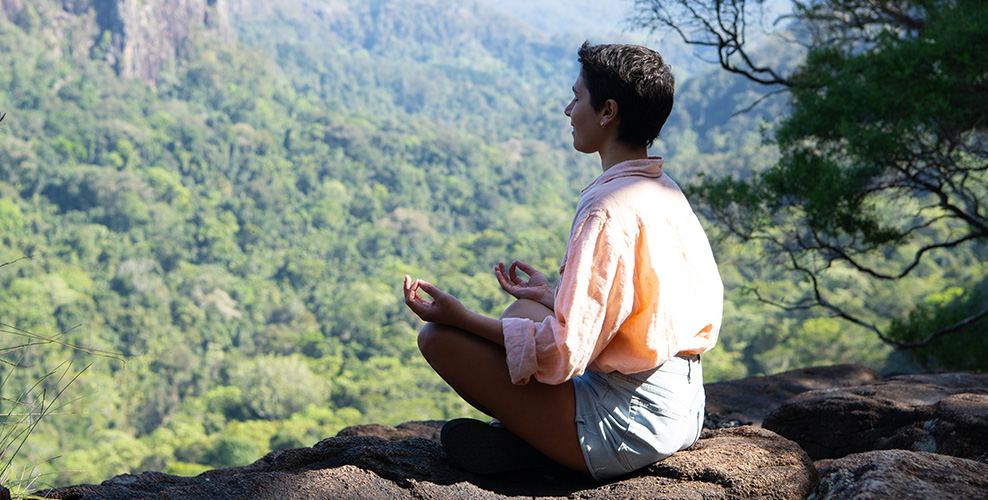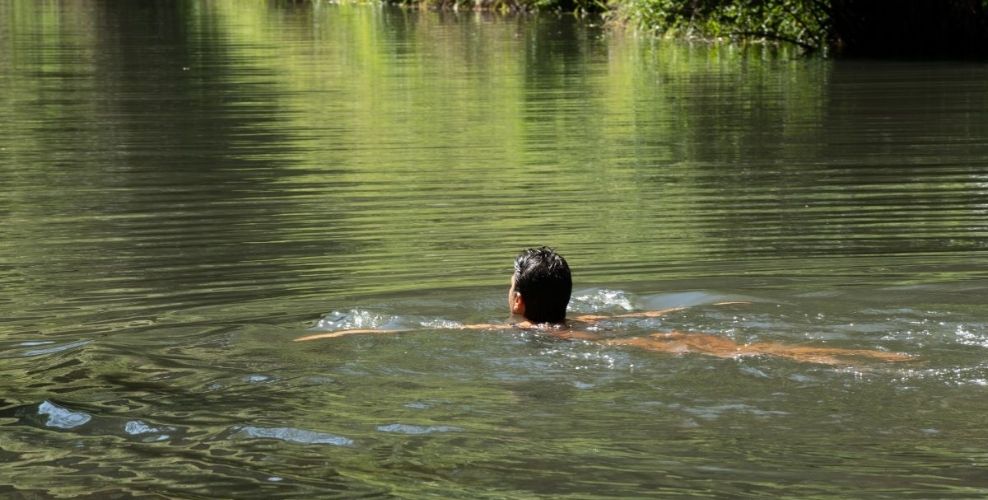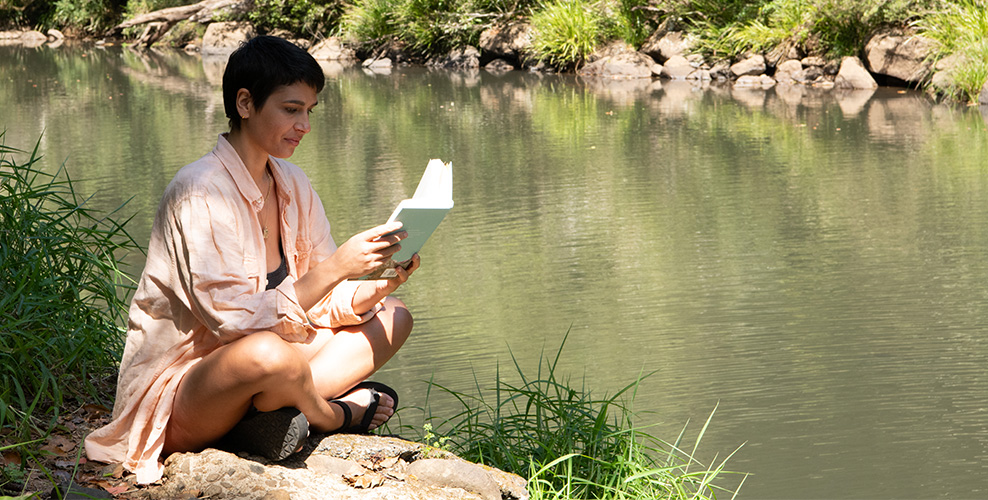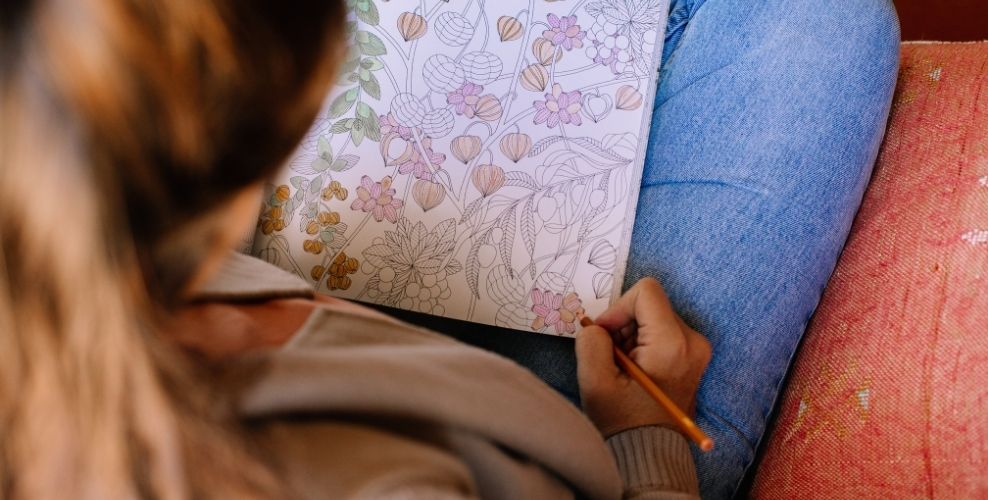Say hi to calm - mindfulness for beginners
Sophia Power, BA Media
Quick overview
- Mindfulness is the practice of staying present and engaged in each moment while staying open, curious and non-judgemental
- The benefits of mindfulness include improved mental health, reduced stress and a greater ability to cope with life’s ups and downs
- Mindfulness has origins from meditation, but mindfulness can be performed anywhere, anytime and can be weaved into everyday life with activities like exercise, mealtimes, and arts and crafts

If you’ve dipped your toe into the wellness pool once or twice then you most certainly would have heard the term ‘mindfulness’ more times than you can count. There’s a reason it’s so popular. A mindfulness practice is supported by some compelling research, as well as anecdotal evidence you may have heard from friends and family.
Despite its popularity, mindfulness as a daily practice is still misunderstood. So, we thought it was time to bring a greater level of understanding to the mindfulness movement. It goes deeper than you might think and could be easier to bring into your daily habits than you may have realised.
Keep scrolling to find out how mindfulness works and how you can sneak it into your day to get instant benefits.
What is mindfulness?
Mindfulness is the practice of staying present and engaged in each moment while staying open, curious and non-judgemental. Mindfulness does have its roots in meditation but, unlike meditation, mindfulness can be practised any time, even while doing other activities.
Mindfulness is called a ‘practice’ which indicates it’s something you need to set plenty of time aside for. Like practising any skill, the more you undertake mindfulness exercises, the better you will get at it. Because you can engage in mindfulness no matter where you are or what you’re doing, it’s easy to make part of your every day and get lots of practise, with the ultimate goal of becoming more present and aware.[1]
The importance of mindfulness
Why is mindfulness so important? Well, the mind can race off in many different directions, constantly – work deadlines, relationships, to-do lists, difficult conversations you need to have, getting the dog to the vet… the list is endless! And this is exactly the point – there will always be something to do, a distraction to focus on. Once the pressure builds up, it can leave you feeling overwhelmed and lacking time and resources.
Mindfulness builds your ability to catch these thoughts before they become a runaway train. Taking a moment to pause and listen non-judgmentally to the thoughts and maybe even taking some slow, deep breaths is often all that it takes. The result can be instant; reduced feelings of worry or anxiety, clarity of thought, regaining perspective and even lowering stress hormone levels.[2]
Mindfulness and meditation – the differences
Meditation has been around since 3000 BC, according to historians.[3] While it was once considered only for yogis and commune-dwellers, you’re now just as likely to find people in a boardroom or school classroom regularly practising some form of meditation.[4,5]
Traditional meditation (including the use of meditation apps) is a helpful technique for relieving stress and improving mental health. It does, however, require you to carve out time in the day to go inwards; as little as 10 minutes and up to an hour is beneficial. It can be nice to sit or lie down somewhere quiet, dark and comfortable.
However, many converts of meditation are likely to be practising meditation as mindfulness throughout the day. This is because it’s so easy to use mindfulness anytime, anywhere, multiple times a day.
Mindfulness focuses on slowing down and paying attention, without judgment or attachment to any thoughts that come up and feelings in your body. By attachment, that means trying not to let emotions hook onto the thought or letting thoughts ‘snowball’ out of control. Notice your thought in a non-judgemental way, acknowledge it and then simply let it go.[6]
Mindfulness can also be developed into a traditional meditation practice, so it’s really about finding the techniques that work best for you.[6]
How can mindfulness help you?
While the focus of mindfulness is about coming back to the present, it also has long-term benefits for the brain. Research shows that these brain changes are physical and measurable. This is what’s called neuroplasticity, where the brain creates new neural connections and grows nerve cells (or neurons) in response to experiences that happen repeatedly.[7]
Neuroplasticity can take place from external input (such as how we are raised or the communities we belong to), as well as internally. So, while you might not have had much of a say as to how you grew up, you have total control over the internal input in the present.
The physical changes that occur in the brain by regularly practising mindfulness have a number of benefits too.

What are the benefits of mindfulness?
Mindfulness practices also can also improve mental health. Focusing your thoughts and attention can improve your attention span, create a greater sense of calm and stability, develop deeper empathy and remove mental blocks around happiness. When you continue to build new healthy habits, such as a mindfulness practice, you are also strengthening the brain and helping to prevent issues of cognitive decline such as memory loss.[8] Some of the other major benefits of mindfulness include:
Reduced anxiety and low mood
Mindfulness-based interventions have been proven to be effective in reducing the severity of symptoms relating to anxiety and low mood. A regular mindfulness practice can also be safely and effectively used alongside cognitive behavioural therapy, a treatment for a range of mental and emotional health issues.[9]
Increased self-awareness
Mindfulness helps to increase self-awareness, helping you to not only build a better relationship with yourself but also to be better at self-regulation.[6] Self-regulation is something that most people learn from their parents but, for various reasons, this doesn’t always happen.
Self-regulation is how we moderate our reactions and emotions to being upset or stressed, maintain adaptability, sustain healthy habits, communicate our needs and develop close relationships. So better self-regulation can have a flow-on effect to all other areas of your life, from work to romantic or family relationships, but, most importantly, your overall wellbeing.[10]
Better stress management
Greater self-awareness and presence is shown to be key in reducing stress. Mindfulness can improve your perception of, and resilience to, stress (because, let’s face it, stress is a part of life).
A 2018 trial looked at the effects of mindfulness on medical students, who generally have higher rates of stress than the rest of the population. The results showed that after only 10-20 minutes of daily mindfulness for 30 days their stress levels significantly decreased, while general wellbeing significantly increased.[11]
Pain relief
Mindfulness has been at the centre of a lot of research into its use in pain management and relief: from the acute such as injury, to chronic, even labour pain.[12] Mindfulness can also be effective as part of a multipronged approach to the management of pain.[13]
Improved immunity
When you’re looking to improve your immunity, mindfulness might not be the first thing you consider. Believe it or not, the connection between mindfulness and the immune system is an area of great interest for researchers. A review of 20 trials showed that a daily mindfulness practice can positively benefit the immune system by reducing inflammation and increasing the activity of immune cells.[14]
It’s part of an area of study called psychoneuroimmunology. To find out more about how it works check out our article, Manage your mindset for immune health.

Mindfulness tips for beginners
It’s natural when you’re starting a new routine or adapting a good habit to want to go all in. The problem is this can often leave you feeling overwhelmed. The easiest way to form a habit is to make a small, achievable goal and build on it.
Here are some super easy tips to build mindfulness into your day when you’re starting out:
- Find a time of the day that works for you, preferably when you won’t be disturbed
- Put your phone on ‘do not disturb’ mode
- Anchor your mindfulness time to another daily habit, such as your morning cup of tea or bedtime routine
- Set a reminder in your phone – make technology work for you!
- Create a 30-day mindfulness challenge in your workplace or home and make it a team effort
- Make the first 5-10 minutes of a solo walk mindful by observing nature, the sensations in your body, your breath and detaching from the thoughts that come up
- Stick a note up in your office as a reminder – whenever you notice it, take a mini break to check in. Stop what you’re doing, breathe deep into your belly, become aware of your thoughts and your body, then sigh it out and let it go (do it now as you read this!)
- Give yourself permission to do one thing at a time. Multi-tasking is the opposite of mindfulness
- Practise mindful listening – it’s a great way to become more engaged, as well as thoughtful about your own emotions and responses
Mindfulness techniques
The great thing about mindfulness is there are so many ways you can do it; all you need to do is find the techniques that work for you.
Here are our favourite ways to practise mindfulness:
- Mindful movement – qigong, tai chi, yoga, swimming laps
- Colouring in books [15]
- Puzzles [16]
- Cross-stitching or knitting
- Mindful eating
- Visualisation or guided meditation videos like this one from Fusion
- Journaling, to cultivate focus, check in with yourself, create awareness around thoughts and thought patterns and declutter the brain. Check out these helpful journaling prompts if you’re not sure where to start [17]
How to do mindfulness meditation
Another great way to practise mindfulness is through a mindfulness meditation. While there are varying opinions about how long you need to meditate for to get a benefit, a daily practice is your best bet; 10 minutes a day of mindfulness is the perfect place to start. Aim to work up to the recommended 20 minutes per day to experience the maximum benefit.[18]
Free guided meditation
We’re big fans of meditation at Fusion Health, so much so that we put together a series of short, guided meditations with meditation teacher Sarah Davis from Living a Brave Life. Check out the series below:
Free meditation apps
Meditation apps are the perfect way for beginners and seasoned meditation practitioners alike to easily practise mindfulness every day. Apps such as Insight Timer, Headspace, Smiling Mind and UCLA Mindful are just some of the many free apps available. Download a couple and try them out to find your favourite.

For more inspiration on weaving mindfulness into everyday activities, check out this article, Mindfulness, Meditation and Mapping out the New Year.
With so many easy ways to weave mindfulness into your day, the hardest part is choosing where to begin! Remember to start small and work your way up to create a sustainable mindfulness practice that will be with you for the years to come.
References
- Mindful. Getting started with mindfulness. Last updated 2019, accessed November 2021 from https://www.mindful.org/meditation/mindfulness-getting-started/
- Turakitwanakan W, et al. J Med Assoc Thai 2013;96(1):S90-5.
- News Medical Life Sciences. Last updated 2021 and accessed November 2021 from https://www.news-medical.net/health/Meditation-History.aspx#:~:text=The%20earliest%20documented%20records%20that,as%20early%20as%203000%20BCE.
- Heckenberg RA, et al. Journal of Psychosomatic Research 2018;114:62-71.
- Mind Space. Accessed November 2021 from https://www.meditationinschools.org/resources/
- Vago DR, et al. Front. Hum. Neurosci 2012;10.3389/fnhum.2012.00296.
- Lardone A, et al. Neural Plast 2018:5340717.
- Vago DR, et al. Current Opinion in Psychology 2019 28:143-150.
- Hofmann S, et al. Psychiatr Clin North Am 2017;40(4):739-749.
- VeryWellMind. How to Develop and Practice Self-Regulation. Last updated 2021, accessed November 2021 from https://www.verywellmind.com/how-you-can-practice-self-regulation-4163536
- Yang E, et al. The Journal of Alternative and Complementary Medicine 2018;24(5).
- Bonura KB. International Journal of Childbirth Education 2018 33(1):6-9.
- Majeed MH, et al. Asian Journal of Psychiatry 2018;32:79-83.
- Black DS, et al. Ann N Y Acad Sci 2016;1373(1):13-24.
- VeryWellMind. Last updated 2021, accessed November 2021 from https://www.verywellmind.com/adult-coloring-books-to-reduce-social-anxiety-4095303
- Sydney Morning Herald. Last updated 2020, accessed November 2021 from https://www.smh.com.au/lifestyle/health-and-wellness/are-puzzles-the-perfect-isolation-activity-20200408-p54i9f.html
- Positive Psychology. Last updated 2021, accessed November 2021 from https://positivepsychology.com/journaling-for-mindfulness/
- The Harvard Gazette. Last updated 2018, Accessed November 2021 from https://news.harvard.edu/gazette/story/2018/04/less-stress-clearer-thoughts-with-mindfulness-meditation/



















